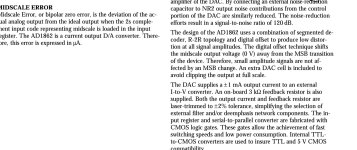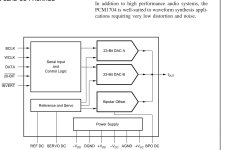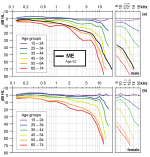Ah ESS, AKM with a tube.
That is quite something different from CS8412 + DF1704 with 2 x PCM63 fed by Motorola 78/79xx and a 4P1L DHT output stage with silver transformers and Rod Coleman regulators.
That is quite something different from CS8412 + DF1704 with 2 x PCM63 fed by Motorola 78/79xx and a 4P1L DHT output stage with silver transformers and Rod Coleman regulators.
Last edited:
? It does have 2 dacs... I think they switch the signal to negative for one one them called BTC , and it is a negative dac which reverse the output,Guess your PCM63 chips were designed by a different Burr Brown.
Its basically a bit inverter and both signals are placed together at output, which guarantee when the digital says to augment the signal volume there is a guarantee augmentation of current, this is not true for when the signal says go down, because that topology is only additive, it cannot subtract noise, it guarantee that noise will follow proportion of the signal, in one dac the noise increase monotonous to the signal decreasing intensity.
When doing this process of BTC one bit is switched to remove the difficult zero crossing poin in the code and down the ladder switches which are increasingly complicated at this point., and the dac lose one bit doing this, both converter are 19bit but the sum is the equivalent of 20 bit... I think..
Pcm63 also I think switches
There are more advanced papers on the dac , the datasheet is a simplification of what they really did.
Ah ESS, AKM with a tube.
That is quite something different from CS8412 + DF1704 with 2 x PCM63 fed by Motorola 78/79xx and a 4P1L DHT output stage with silver transformers and Rod Coleman regulators.
Yes a lot different.
I had a discusion with man who worked in Soviet Union transistors manufacturing facility. He is engineer but perfectly understand me why "SAME" parts with same schematics sounds and performs diferently. In western there was better consitency but.. even same factory same month "nearly" same materials and dias process and.. diferent batch can sound diferently! for example SUBJECTIVE sonic diferencies in rs422 line driver made by same factory withing 3 years is noticeable. and I mean same factory. sometimes even marking are identical.Well, Signetics/Phillips is the only real 5532/5534. TI and other versions are not at that level. As for the 78/79 regulators, I only use it for auxiliary circuits, and I don't look at the manufacturer.
I have learn those lessons with silly xepierence when i hoped that same manufacturers always provide same sound performance regardless of manufacturing data and even regardless of assembly facilities. Audio is very funny thing.. JRC 7815 and Motorolla 7815 sound very diferent. oposite of spectrums actualy. And I am sure you would hear diferencies. whether you prefer LT1963 ar some specifific 78xx is already matter of taste and matching sound to circuit needs. there is good sounding LDO but olde type regulators is sometimes better sonicaly.
I believe you. There are certainly deviations in production over the years. I have noticed that the older AD1865s from the beginning of production sound better than the newer ones near the end of production. Those old ones can be found on ebay but used, unsoldered from old devices. They are still working, but for how long we don't know.
Yes, it is the same with ad1862, pcm1704. Each tech is differently named for the same thing 🙂Pcm63 also I think switches
Jean paul- good one 🙂 but even there I actualy prefer european cars made until 2008 and US cars around 2012-2016. Those features older non direct injection engines with proper engineering for durability rather than eficienty. I cant speak about new woman because i have only one new. can not comapre with another new ones but she was not very good. probably not properly burned-in .
if we get back to topic- is there anyone still thinking that PCM63 is neutral (by subjective tone)? my expierence with pcm63 (since 2004 june- which is 21 year by now) tell that its not. i know many DAC chips ae not neutral but pcm63 is special in this regard. like PMD100 digital filter- its far from neutral. but feed it with two regulators, try difrent dithering modes , use selected electrolytic for it and its flaws decrease why its good sonic preserve. its like cooking. on the other hand pcm1704, or DF1704 always quaranty nice result without sounding "off"
Have you tried PCM63 without digital filter and oversampling? What would some call the improper application.
The regulators 7xxx are worse than 3xx and discrete compound such and al lt34xx , then there are private companies who make regulators which are suitable for working over 100khz , I would use the datasheet decoupling capacitors values, blackgates or film.
Passive i/v and nos is imo, after measurement and many auditions a filtered inadequate sound, maybe it can measure right it will fall appart if listening to recording of sounds found in nature
Passive i/v and nos is imo, after measurement and many auditions a filtered inadequate sound, maybe it can measure right it will fall appart if listening to recording of sounds found in nature
Attachments
no, but i have tried pcm1702 in NOS OS mode where dac designed in way you can disable OS(digital filter sm5813). NOS is much more brutual and more imedate midrange which jumps at you. but absolutely flat sound wth no soudstage depth and high frequencies is very unclear. if music is one vocal in the center maybe NOS could grab somebody atention. but on most music especialy clasical everything colapses. nothing high end at all. and the better speakers the worse sound of NOS dac. and all this with RCRCRC analog filter.(which by itself shifts phase and spoil sound-find simple RC is good compromise between atenuation and phase shift angle) i could not imagine what would be with simple RC or without filters liek some guys listen. so as for myself i am against NOS.Have you tried PCM63 without digital filter and oversampling? What would some call the improper application.
I have the datasheet.? It does have 2 dacs... I think they switch the signal to negative for one one them called BTC , and it is a negative dac which reverse the output,
Its basically a bit inverter and both signals are placed together at output, which guarantee when the digital says to augment the signal volume there is a guarantee augmentation of current, this is not true for when the signal says go down, because that topology is only additive, it cannot subtract noise, it guarantee that noise will follow proportion of the signal, in one dac the noise increase monotonous to the signal decreasing intensity.
When doing this process of BTC one bit is switched to remove the difficult zero crossing poin in the code and down the ladder switches which are increasingly complicated at this point., and the dac lose one bit doing this, both converter are 19bit but the sum is the equivalent of 20 bit... I think..
Pcm63 also I think switches
There are more advanced papers on the dac , the datasheet is a simplification of what they really did.
I have the actual chips.
I can build and confirm that it does what BB says it does.
So what is the point of posting such gibberish when the correct information is so readily available?
What you are describing I have never heard. That's the sound of grandma's Telefunken. And I made about 10 DACs without oversampling and output filters. I made two DACs with transformers at the output 1:1 due to DC voltage removal and BAL/SE and SE/BAL conversion which is an analog filter 4th order at some 80kHz, and on the others I have a preamplifier, amplifier and speakers as a filter. I've never heard such an extreme sound with attacking mids, cloudy highs, no depth and 3D images, just the opposite of that. RCRCRC analog filter is a nasty thing, as you noticed. I would never put that on any device, nor any digital filter.no, but i have tried pcm1702 in NOS OS mode where dac designed in way you can disable OS(digital filter sm5813). NOS is much more brutual and more imedate midrange which jumps at you. but absolutely flat sound wth no soudstage depth and high frequencies is very unclear. if music is one vocal in the center maybe NOS could grab somebody atention. but on most music especialy clasical everything colapses. nothing high end at all. and the better speakers the worse sound of NOS dac. and all this with RCRCRC analog filter.(which by itself shifts phase and spoil sound-find simple RC is good compromise between atenuation and phase shift angle) i could not imagine what would be with simple RC or without filters liek some guys listen. so as for myself i am against NOS.
Last edited:
I dont know if my findings is correct. its only one trully OS/NOS DAC which is capable testing OS/NOS difefencies is SAME DAC and same surrounding circuits(I also temporaritly replaced digital filter in proceed DAC with jumpers and 74hc04 but i did not make extensive comaprision)What you are describing I have never heard. That's the sound of grandma's Telefunken. And I made about 10 DACs without oversampling and output filters. I made two DACs with transformers at the output 1:1 due to DC voltage removal and BAL/SE and SE/BAL conversion which is an analog filter 4th order at some 80kHz, and on the others I have a preamplifier, amplifier and speakers as a filter. I've never heard such an extreme sound with attacking mids, cloudy highs, no depth and 3D images, just the opposite of that. RCRCRC analog filter is a nasty thing, as you noticed. I would never put that on any device, nor any digital filter.
I dont believe in any comaprissions "from memory" or comapring diferent devices with diferent circuits one having OS other NOS. Unless person who is doing that works on the field where good sonics memory is a tool. Because psychoacoustics is real- not imaginable. Jus like pregnacy. We may fool ourselves that girl gained weight for some time thought.. I believe in wider perspective. To judge something lot of diferent devices should be around and its forbiden to get accomodate to one, because psyho acoustics kick in. And not all of those devices should be DIY. IF i would listen /would have more devices which ar NOS i may accomodate to this sound.
I have few DAC (Wadia) with is not NOS but closer to ir by used digital filter topology and I hear some grainy uncler hights on some records whe comapre to other dac. It doesnt hep that all wadias I have ommits analog filtering on top of that simple low tap dsp filters.
I dont think NOS without upsampling to 192khz+ and multiple pole filtering in DAC and amplifier input can sound without consequences.. On the other hand i dont sonicaly like higher order analog filters even with OS DAC. 1st order is best sonicaly.
I understand that its comes not from academic couriuosity. but ist an interesting question. and a good one. and worth longer answer(just probably not in dac section)have you checked your hearing at the specialist recently? It would seem you are quite limited.
Last time i was on professional audiometry in 2019 autumn my hearing was normal. I was able to hear 16khz and 12.5khz in 25db levels(loudness curve added). during test I didnt like methods(no masking other ear, diferent headphones for 8khz and 8khz up+ which ddnt showed same results in lower frequencies (1-8khz) even its called professional it more for elderly people checking level of defness or some SSHL cases.
i test my and other people hearing(i need t for my job) quite often. I made calibrated and corected response source (from sb acoustic satori tweeter) better than headphones (which response greatly - + 5/12db depends on wearing position. tweeter when palced eaxact 1-1.5cm from ear frequency response is quite flat. its fed by Tascam US122mk2 so perfectly silent. this source provides 800hz - 20 000khz response flat up to +-1db with maimum devations +-2.5db
in very very silent room few younger people (30yo) was able to hear 3- 5db @ 1khz and up to 12khz@25db level and 16.5-17khz @60-70db levels.
mind that those are numbers without FM or ANSI loudnes curves(so you can reduce threshold by 7-10db in 8-11khz range)
any measurements below 500-800hz in levels lower than 25db would not be possible without chamber. but hering very rarely degrades on lowest fequencies (unless some rare cases like later stage Miniere disease)
in my 46 I still can hear 15.2khz at higher SPL and 8.8khz with 30db level ( would be around 20db if loudness corection included which are always included in audiometry tests)
older (50+)audiophiles can hear only from 25-30db@1khz and 8-10khz~ 50db which is quite loud. some i tested cant hear 9khz a 80db levels. one 60yo male still hear 8khz in 25db level (and 14.5khz at 70db level )whch is quite extraordinary to hear tones that high in that low treshold. and he visited and stll visiting lot of rock concerts so we are all diferent and genetic plays role, not only enviroment.
luckily our brain is perfect DSP, even persons who already have hughe drop in high frequencies need only 2.5db more level than young person who hear 10khz basicaly same level as 3khz The diference in hearing between those people is 10khz is more than 40db, yet only 2.5db elevation in speakers is needed subjectiively expierence same level of frequency response.
for academic purposes ataching average hearing of variuos ages .
Attachments
Last edited:
- Home
- Source & Line
- Digital Line Level
- Calling DAC experts for ultimate PCM63 DAC


